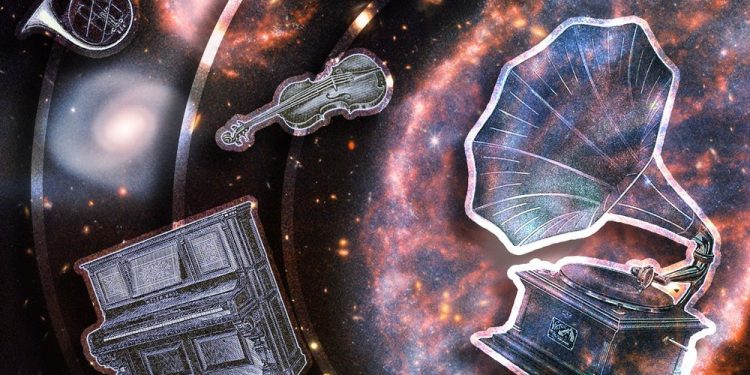Just as songs repeat in choruses, formations in space take understandable shapes. Pictured here are the large Cartwheel galaxy and two smaller companion galaxies.
NASA / Illustration by Emily Lakiewicz
I’m not a scientist—I routinely Google the answers to my daughter’s fourth-grade math questions—but I do practice a kind of science: I’m a songwriting professor, and up through the Renaissance, music was considered a close relative of math, geometry and astronomy. That may be hard to imagine today, but as I check out the startling images that the James Webb Telescope has been beaming back to us since July—the spiraling “cartwheel” galaxies, binary stars and echoes of the Big Bang—I can see the connection. In astronomy, elements “solve” into understandable orbits or familiar chemicals; in music, they “resolve” into choruses and melodies we can sing back.
Consistently repeatable answers might not be surprising in fourth-grade math, but when a high-powered telescope provides instantly recognizable patterns floating hundreds of millions of light years away, it’s hard not to ask: How is that possible? And similarly, in the realm of music: What causes us to create, and respond to, a similar kind of repetition in our art?
Here’s a wound from early in my teaching career: After listening to a student’s song in class, I suggested he repeat a phrase. When he asked, simply, “Why?” I realized that I didn’t have a satisfactory answer beyond, “Well, that’s just the way most songs are written.” Was it mere tradition? Commerce? Laziness? I didn’t sleep that night. I needed a better response.
Philosophers and writers have long agonized over the nature of repetition and its appeal to the human mind. They’ve discussed past lives (Plato), time spirals (Gianbattista Vico), eternal returns (Friedrich Nietzsche) and the possibility that repetition isn’t even possible (Heraclitus). Unfortunately, none of the ideas I found were particularly helpful, especially for a songwriting class. I wondered if a universal answer might instead come from the universe itself.
I wrote my newest book, Music, Lyrics, and Life: A Field Guide for the Advancing Songwriter, the same way I write songs—I started with a question, followed it, and hung on for the ride. Many of the experts I interviewed weren’t songwriters, but still grappled with similar questions in their own fields, and in their own ways: This was definitely the case with cosmologist Janna Levin, a 2012 Guggenheim fellow who currently holds the Claire Tow Professorship of Physics and Astronomy at Barnard College. Levin’s 2016 book, Black Hole Blues and Other Songs from Outer Space, tells the story of the Nobel Prize-winning team that helped build the Laser Interferometer Gravitational-Wave Observatory (LIGO), which detects gravitational waves caused by black holes as they “slosh in space-time…like waves on an ocean.” (Incidentally, you can hear gravitational waves for yourself, right now.)
What I got from Levin was more than an explanation of musical repetition. It was a new interpretation of reality itself.
Songwriters and astrophysicists have an affinity for repetition. It’s frequently used as a tool in music, but for astronomers, there seems to be an assumption that repetition implies forces that are purposefully at work, perhaps even intelligently so.
Absolutely. One of the things SETI—the Search for Extra Terrestrial Intelligence—does is that they look for very regular mathematical signals because they assume that nature won’t provide such a thing—nature’s messy, and so nature can’t do anything so regular. So if you find an incredibly regular signal, you’re hoping that it was sent by somebody who controls their environment, who made it go that way.
But sometimes we’re wrong about that. Have you heard about pulsars? There are big stars that collapse and die, and they don’t quite make black holes—they’re not big enough—so they make a neutron star. And the neutron star is spinning, and it has a huge magnetic field and it basically becomes a lighthouse. It literally has a beam of light, and as it spins, that beam sweeps past you, not irregularly—radio astronomers detected one, and it was clock on, man. Clock on! I don’t remember if it was a millisecond or a second sort of timescale. But it was like, boom, boom, boom, so regular that [astronomers] jokingly called them LGMs, which meant “little green men.” And then over time, they realized this is a natural source. [A pulsar] is just a perfect clock. Over billions of years, it will not slow down. And it will not waver. And that can happen, that nature makes something that’s so perfect.
What does it say about humans that we’re so intrigued by repeated information?
I am a big believer that we inherit mathematical structures because math made us. Evolution is guided by forces of nature—that’s how we evolve—and those forces, not surprisingly, leave an imprint in the structure of our minds. Of course they have to be mathematical. And in some larger, genetic sense of who our family was, who our parents were—our parents were the laws of physics. And in our minds, it’s encoded there. And we’re discovering the structure of our minds. So I can sit there with a piece of paper and discover algebra, and discover geometry, discover topology, discover different branches of mathematics, because it’s in my mind.
There are also communications within the animal kingdom, like birdcalls, that repeat. And the repetition corrects for errors. So, you know, if you didn’t get it the first time, you get it the next time ….
We want to be unique in language, but we also want to be repetitive enough that you recognize the words. I want to say those words to you over and over and over again, like with children—and then they acquire language. You need the repetition first to understand what the words mean, but then I want to be able to say something unique by assembling those words in a certain way.
That’s a basic theory of songwriting—choruses that repeat and teach themselves to the listener . . .
Right. LIGO has a real hard time detecting something that only bursts once. It has to repeat for it to be able to pull it out. In fact, one of the things we really hope from LIGO going forward is that it will hear something for long enough that it’ll be able to hear repetitions. That’s exactly what it’s going to want to look for. And those repetitions will allow it to identify something. You know, it’s like if somebody screams in the street, you’re like, “Did I just hear that?” And then if it’s over and over again, you’re like, “Oh! Something’s gone down!”
That’s what I’m talking about!
That’s what science is about—reproducibility, experimentation, the fact that somebody else can do it and get the same answer. I was talking to someone from Oxford who said, “Look, this is a real experiment: In your mind, imagine a circle, divide it by the diameter. You have just derived the formula for pi. That is an experiment. And anybody can do the same experiment in their minds and get exactly the same answer.”
I consider that to be as tangible as anything. It might not mean that I physically, externally, took out a tape measure, right? But that is as real to me as if I had, and in some sense it’s more real because my tape measure is imperfect, but in my mind, it’s perfect. How is that not real? That’s real.
So, repetition, whether from the same source or the same computation, makes something real.
I think a lot of people who are as inclined as I am toward abstraction struggle with “reality” because it’s less real. “What do you mean that chair was blue? I think it’s persimmon-colored.” “I think it’s lavender.” Like, there’s less reality in reality than there is in our minds. So it’s quite comforting to know that if you’re from Bangladesh, 200 years ago, and you did the same pi thought experiment, it’s 3.14159 etc. There’s a sense of connectedness that’s very profound. So I think if you think of repetition as an evolutionary trait, then it makes sense that we have it.
And the reproducibility of something like pi connects us to each other, and maybe to whoever’s out there.
Without any flaws, without any guru, without any error—just the pure terrain of the thoughts. There is no experiment in the history of humanity that will conjure pi. It will conjure an approximation to pi, but never pi itself. The only place pi exists is in my mind, and yours. And if we both do it correctly, we will be amazed that, no matter where we are in the universe, we will get the same digits. How is that not real?
Astronomers
Astronomy
Music
Outer Space
Songs
Recommended Videos
Source by www.smithsonianmag.com


